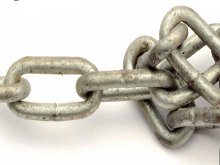The choice between chain and wire rope?
25 March 2013Steve Cordell of D. R. Cordell & Associates explains how to make the choice between wire rope and chain on a hoist and avoid the pitfalls of getting it wrong.
When comparing electric chain hoists and wire rope hoists for a lifting task, you should consider the application, environment, capacity and duty cycle. Equipment that is applied incorrectly will require premature or excessive maintenance, create inefficiencies, and cause downtime all resulting in higher cost of ownership and reduced efficiency.
Scenarios
A chain hoist, for example, might be misapplied if used in a steel service center where the duty cycle requires the hoist to operate throughout the day making picks that approach 50 per cent of the rated capacity frequently.
While electric chain hoists produced today are durable products, high duty cycles generate heat in motors, controls, and mechanical components that cannot dissipate efficiently resulting in equipment failure and downtime.
Electric chain hoists should avoid installations where excessive dust, dirt, or debris are present in the environment. The lubricated chain links attract particulates creating an abrasive compound that will cause premature chain wear in this setup.
The abrasive compound enters the hoist by passing over the internal pocket wheel causing additional damage or creating a situation with potential for equipment failure.
Wire rope hoists should avoid being installed on manually operated crane equipment like a jib crane, small gantry crane, or hand push bridge crane. The traverse movement of these types of cranes is typically achieved by pulling on the hoist load hook or lower block and often results in the wire rope becoming unseated from the grooved drum or damaging the rope guide. Unseated wire rope will become damaged creating a safety hazard and requiring replacement. Even the best trained operators cannot monitor the rope status continuously, therefor it's best to stay with electric chain hoists for hand push traverse applications. Chain hoists are also lighter then wire rope hoists, requiring less manual effort to move the load. Wire rope hoists should avoid being installed in applications where protection from contamination and ease of cleaning are necessary. These installations could include clean rooms, food processing, and medical and high tech manufacturing where dust falling from the equipment could result in contaminated or unusable product. The larger construction features of the wire rope hoist include multiple surfaces and resting places for debris making cleaning difficult. Electric chain hoists are compact and typically contained in an enclosed body making cleaning easier. Grease lubricated gearing found on some electric chain hoist brands reduce the potential for contamination from gearbox oil and are well suited for clean environments.
Outdoor installation
Both the electric chain hoist and wire rope hoist can be installed outdoors when specified properly and approved by the manufacturer. Wire rope hoists can be customised for special applications due to their larger frame sizes and open architecture. The compact electric chain hoist is limited to the customisation options available.
Industrial application electric chain hoists range in capacity from 1/8 to 5t. Some brands manufacturer larger capacity electric chain hoists that are used in rigging, mining, and marine applications. Higher capacity chain hoist installations are application driven by physical constraints, weight, environment, or project requirements common to specific industries.
Industrial application electric chain hoists 5t and under are excellent tools for light to medium lifting duty cycles classified as H3 or H4 service by the Hoist Manufacturers Institute (HMI).
Electric chain hoists in this capacity range would be suitable for machine shops, assembly operations, workstation lifting equipment, and maintenance operations. Their compact design, light weight construction, and low investment cost are what make them ideal for these types of applications. When installed on a jib, gantry, or hand push crane the pulling of the load hook or lower block for system movement will not affect the load chain. It should be noted that manually operated crane systems are most efficient when mounted no higher than 15' from the operator floor. Higher elevations than this could produce a 'slingshot' action when moving the crane system.
Industrial cataloged wire rope hoists range in capacity from 1t up to in excess of 30t capacities. They are better suited for higher capacity lifts that occur frequently throughout the workday.
Because of the larger components such as gearing, body, and controls, they can withstand more heat generated by frequent lifting. Their ideal applications would include high capacity loads found in steel service centers, foundries, steel mills, lumber mills, and other high production environments where the duty cycles are medium to heavy and classified as H4 or H5 by the Hoist Manufacturers Institute.
Because of their geometry, wire rope hoists are easily modified with special controls, custom configurations and environmental protections to suit a variety of customer requirements.
Getting to grips with requirements
Your hoist supplier should be asking you important questions to understand your requirements; such as application, environment, capacity and duty cycle. Share the information and provide as much detail as possible so you both understand what will make your next hoist installation successful.


